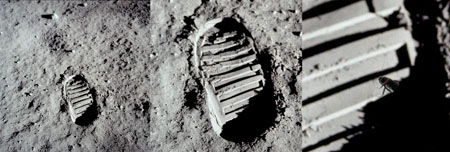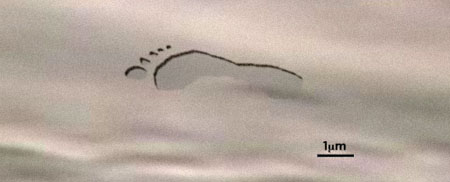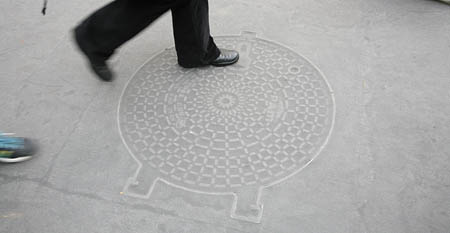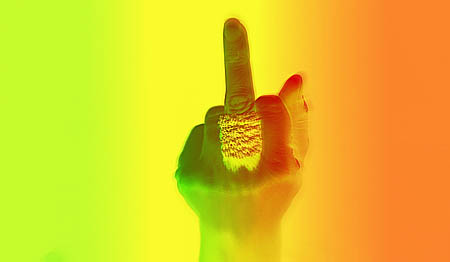6 mars 2011

Il est des images troublantes, non par leurs propriétés esthétiques mais parce qu’elles font osciller, dans l’esprit du regardeur, le « ça a été » de Barthes, entre doute et certitude. Mais aussi parce qu’elles sollicitent la suspension de notre incrédulité là où la science devrait faire foi, de droit. Parmi celles-ci, les images de la mission Appollo 11 sont exemplaires. Qu’est-ce qui fait la force d’une empreinte de botte de caoutchouc dans le sable pierreux ? A la fois ce que l’on sait du contexte de prise de vue (une trace manifestement humaine sur le sol vierge de la Lune) et ce que le doute nous fait craindre la valeur de témoignage du document.
Lire le reste de cet article »

Loading ...
Publié dans critical fusion, photography |
20 janvier 2011

Deux ans avant le changement de siècle, un comité dirigé par Jean-Jacques Aillagon, alors directeur du Centre Pompidou, reçut la charge d’imaginer les cérémonies de célébration du millénaire. Curieusement je fus convié à participer à la réflexion.
Les propositions que je fis alors, visiblement en décalage complet avec les attentes implicites des commanditaires, furent systématiquement écartées. Ma première proposition, notamment, jeta un grand froid dans l’assemblée. Prenant en compte le fait qu’un tel événement serait célébré et observé par la planète entière, il importait d’émettre un signe fort à la face de l’humanité, toujours sensible à l’image des Lumières, de la révolution et des droits de l’homme, attachée à la France. On ne saurait se satisfaire des feux d’artifice à la symbolique troublante et autres festivités qui en diraient trop peu sur la vision que nous aurions d’un futur si proche.
J’avais donc proposé de lancer un appel au peuple pour la réécriture des paroles ambiguës de la Marseillaise. Le nouveau millénaire consacrant la réduction de la planète aux proportions d’un village, sinon d’un hameau global, je pensais qu’il convenait de reconsidérer les relations de voisinage. Nous avons trop clairement oublié ce que le sang des autres, nos prochains, nos proches, aurait de suffisamment impur qu’on se proposât d’en abreuver nos sillons, et de prendre les armes pour cela.
Lire le reste de cet article »

Loading ...
Publié dans change the world, come back, critical fusion, writing |
15 décembre 2010

a Nano Step for Mankind
players: Deepak Srivastava (Nasa), Victoria Vesna (UCLA), Sarah Diamond (Banff Centre), and many others… in 2003
The following text was written in the context of the Carbon versus Silicon think tank, gathering artists and scientists at the Banff Centre in 2003. During the conference, I was impressed by the high scientific level of the participants, and I felt embarrassed by my position as an artist, hardly trying to get the big picture. I was just wondering about the legitimacy of most of the graphic representations of the nano world that was for me more interpretations and justifications of theories, as if one would be trying to persuade the audience of the credibility of a desirable fiction.
I decided to do a performance for my conference. The text of my power point presentation should be at the same time and the definition of an art project questioning the scientific and/or aesthetic issues of the emerging nanotechnologies.
Probably because of the complexity of its features, this project has never been done.
Arty-Fiction
Tractacus Nano-Sociologicus
Lire le reste de cet article »

Loading ...
Publié dans Augmented Reality, come back, fiction, interactive installation, performance |
3 novembre 2010

STEP and SHOOT
player: FIAC 2010 Paris
Bored by a vision of the world dominated by B2B (Business to Business) and B2C (Business to Consumer) that seem for so many people to be the only way to consider human interactions, I would like to start a series of works called H2H: Human to Human.
The first work of the series would be the manhole covered by a used carpet during Paris FIAC (Foire Internationale d’art Contemporain) 2010. I felt compelled by this reversed foot print, drawn by the visitors of this exhibition where art is for sale. I started thinking of an “interaction design†process: every time a foot touches what I consider as an “interaction zone†I would trigger my photo camera. This very simple human driven interaction process takes an external input to connect two actions: stepping/clicking making me the slave of the program. STEP and SHOOT.

Loading ...
Publié dans Human to Human, easy pieces, interactive design, photography |
2 novembre 2010

Player: Adam Smith
Le concept de la Main Invisible développé par Adam Smith m’a toujours fasciné. En ces périodes électorales étasuniennes où il est brandi comme argument ultime, quasi mystique, pour justifier la position de ceux qui pensent que leur égoïsme assumé est une forme de générosité indirecte et qu’une main invisible redistribuera les richesses qu’ils auront acquises, il est temps de remettre icônes et croyances à leur place.
Je propose la création d’un hologramme sur lequel la Main, exprimerait sans ambiguïté sa générosité profonde, dans un geste ferme, le majeur dressé, luxueusement couronné de valeurs résolument et définitivement acquises.

Loading ...
Publié dans Business Model, change the world, not sure, photography |
8 juin 2010
player: Itau Cultural, summer 2009
Title for a carefully-selected-interactive-installations art exhibition.

Loading ...
Publié dans Titlism, curating |
8 juin 2010
players: World Skin, Itau Cultural, Sao Paulo, Brasil, summer 2009
Installing media art installation can be a painful experience.
Project: The first virus zoo with a nice collection of Trojan Horses

Loading ...
Publié dans Collection |
7 juin 2010
(another) Original Curatorial Project

Loading ...
Publié dans Titlism, curating |
7 juin 2010
Players: Agnieszka Kulazinska, Åaźnia, Centre for Contemporary Art, Gdansk, Poland
Original Curatorial Project (OCP)
The easy way: The exhibition could have walls covered with big artists’ names.
or: to exhibit unknown artists with names that sound close to the big names from the art history (van Gogh, Delacroix, de Vinci, Mondrian…)

Loading ...
Publié dans Titlism, curating |
7 juin 2010

players: Agnieszka Chojnacka, the Dump exhibition, Åaźnia, Gdansk, Poland
After the Dump exhibition at Åaźnia presenting works inspired by the Dump projects made by other artists, I like the idea that I could be inspired back by the resulting artworks and define new projects to be dumped or done.
I thought again about what could be a Dumped project done to be hacked. Thinking also at the same time of the Never Ending Story, Try to make the world more intelligible, even if for you it is totally unintelligible presented by Agnieszka Chojnacka an interesting brilliantly done sound interpretation of the project Black Hole from the Dump. I propose to produce the Never Ending Project as a Dump post written in a way that the reader would be invited, before reading the project, to replace words of the project post by themselves. The description of the project would permanently change and become the result of every participant’s experience. Done at different period of its evolution, this project would open to an unlimited variety of works.
The most difficult thing is to write its structure in a way that would keep consistent the resulting reader-altered proposal.
PS. My previous web work using evolving open text is and what about me? 2 (1996) where we are invited to help rewriting the Genesis first seven days.

Loading ...
Publié dans Dump structure, interactive design, writing |












